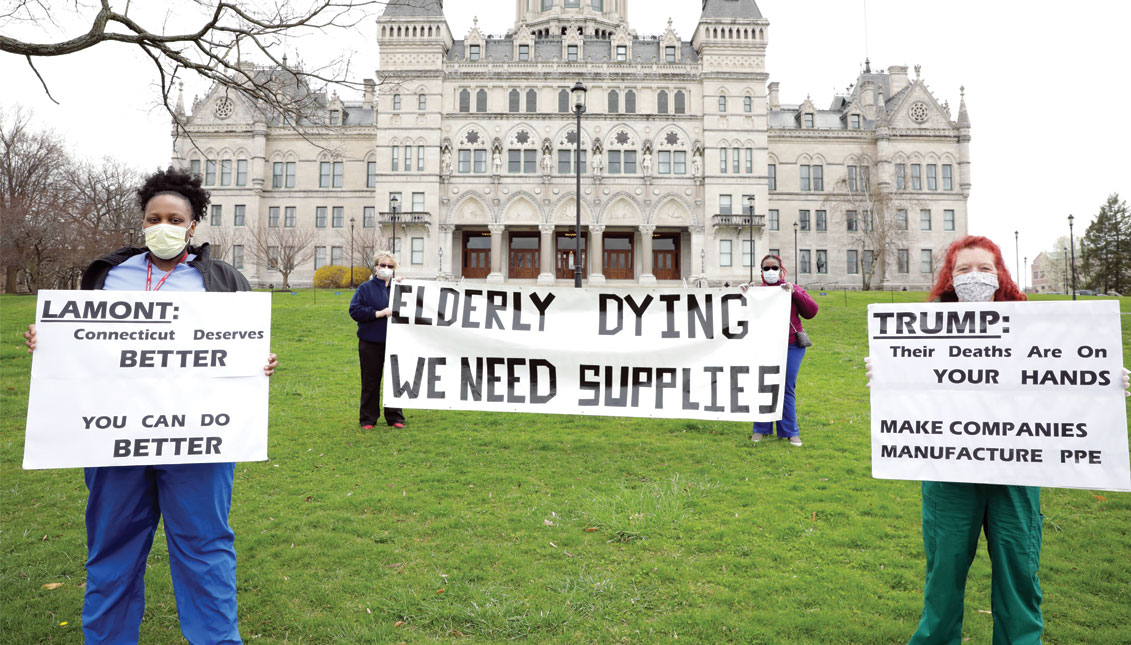
Nursing Homes: Pennsylvania's Ground Zero
Pennsylvania plays catch up in a race to protect its nursing homes from coronavirus.
Back in the early stages of COVID-19 in the U.S., there was an early warning sign of where the virus would hit hardest. In mid-March, the Life Care Center of Kirkland, Washington, became the country's first concentrated hotspot of coronavirus.
The result was grim, as 37 deaths attributed to COVID-19 occurred in the nursing home and rehabilitation center. Both state and federal authorities have also since found failures in following protocols at the center and leveled a $600,000 fine on the facility.
In the two months since the disaster in Kirkland, similar tragedies have occurred across the country as coronavirus moves in silence through nursing homes.
Pennsylvania is no different.
Governor Tom Wolf's administration was among one of the first on the East coast to shut down its state to combat the spread of coronavirus. It started with shutdown orders in the suburban counties of Philadelphia before spreading statewide.
But PA lacked similar swift action when confronting the virus in its nursing homes.

Spotlight PA obtained documents at the beginning of May that laid out an early plan the state had for containing the virus specifically within its 696 nursing homes. The blueprints from mid-March detailed the creation of quick-response teams made up of epidemiologists, nurses, emergency management personnel, and medical experts that would respond to calls for help within six hours.
Once arriving on the scene, the teams would assess the facilities' needs and create a plan of action, which involved distributing personal protective equipment, identifying potential quarantine areas for infected residents, and training the staff prevention strategies.
The plan was supposedly circulated within PA's Health Department via email and then sent to the state's nursing home providers, but April Hutcheson, a spokesperson for the state, told Spotlight PA that she was unaware of the plan.
Still, Hutcheson said some concepts of the plan were still put in place, and State Health Secretary Rachel Levine has said nursing homes were always a focus for the administration.
Regardless of their efforts, nursing homes have still transformed (as in other parts of the country) into the epicenter of PA's fight against COVID-19. More people outside than in the state's long-term care facilities have coronavirus, but more than 70% of PA's deaths attributed to the virus have occurred inside them.

Another area surrounding its nursing homes where PA has lagged behind is in reporting the cases that occurred there.
Back when coronavirus first entered the state, individual counties and local news outlets were the only resources the public had at its disposal to learn about COVID-19 in nursing homes.
Counties weren't initially required to disclose nursing home data.
Outside of Philadelphia and Montgomery counties in Southeastern PA, which reported their early COVID-19 case and death counts in nursing homes, other counties remained mute unless highlighted in the local press, which still gave an incomplete picture.
Across the state, a similar struggle was taking place, as local news reported a dire situation at Brighton Rehab in Beaver County, PA, outside of Pittsburgh. The facility had consulted the state's health department, which advised to stop counting cases in the facility and assume all 450 residents and 300 staff members were infected with COVID-19.
Not long after the incident, PA began requiring counties to report nursing home data to the state, which would then publish resident and staff case counts by county on its website.
Despite reporting the case counts by county, it did not publish the cases by individual facility until May 19, much later than neighboring states like New York, New Jersey, Maryland, and Ohio.
The move came not after growing calls for further transparency — which existed — but after a change in federal regulation that required facilities to report their case counts to federal officials and to notify residents and families.
Two weeks ago, Levine ordered under Governor Wolf's emergency order for nursing homes to begin filling out surveys that would be submitted to the state requiring COVID-19 data. The surveys were submitted on Saturday, May 16, and were the basis for the initial data dump on May 19.
Early reports, like one from The Philadelphia Inquirer, cite wide discrepancies in the number of cases reported by the state in certain facilities and the actual numbers.
The gaps go both ways.
The Inquirer told the story of Elwyn Harmony Hall, a home in Delaware county for adults requiring mental health care. The facility can only accommodate 16 residents, but state data had its case count for residents at 65.
Other facilities have also reported state case counts lower than the actual number.
Nate Wardle, a spokesperson for PA's Health Department acknowledged the discrepancies and attributed them to how the local data had been recorded into the state's system.
"We are working to correct these issues," he told The Inquirer.

RELATED CONTENT
Part of the reason the state's data is inaccurate or incomplete could also be because PA has yet to implement a robust universal testing plan for COVID-19 in its nursing homes.
The state has 20,000 test swabs to distribute from the federal government — which is well under what is needed because of chronic national shortages throughout the pandemic — but is filling the gap by helping nursing homes independently acquire testing kits and contract labs for processing them.
Surrounding states like Maryland, West Virginia, New York and New Jersey all have a universal testing plan for nursing homes and are in various stages of completion, but PA's, which was unveiled the same time as the required reporting plan for facilities, is less stringent.
For one, participation is voluntary, which opens the door for bad-acting facilities to escape proper inspection.
Journalist Chris McGreal, in a piece for The Guardian, warned of an industry already "notorious for creaming profits off while pleading poverty to pay a low-wage workforce."
The unlivable wage means many employees in these facilities hold two or three jobs to make ends meet, risking further exposure to coronavirus, which is then brought into the facility to spread like wildfire.
From the initial data reported by PA on May 19, 30 long-term care facilities in Southeastern PA did not appear.
The state's guidelines for universal testing also only required everyone in a facility to be tested if a case of COVID-19 had been reported. Other facilities with no cases would have 20% of the staff and residents tested on a weekly basis. According to data gathered by Spotlight PA, at least 561, of the state's 696 nursing homes have reported COVID-19 cases.
The plan also only calls for testing in the state's nursing homes, leaving some long-term care facilities off the list for aid.
For nursing home advocates, PA's slow response has opened the door for homes to ignore guidelines and cost lives, but the state hasn't been completely mute towards bad actors.
While not releasing the names of specific facilities, Pennsylvania Attorney General Josh Shapiro's office announced on May 12, that it is investigating nursing homes in the state for criminal neglect.
Pennsylvanians with concerns about certain homes are directed to email neglect-COVID@attorneygeneral.gov.
"Protecting seniors and our most vulnerable in the care of others, is one of the core responsibilities of my office and we're stepping up to protect older Pennsylvanians during this crisis. We will hold nursing facilities and caretakers criminally accountable if they fail to properly provide care to our loved ones. While we salute and appreciate nursing home staff on the front lines during this pandemic, we will not tolerate those who mistreat our seniors and break the law," said Shapiro in a press release about the new effort.
Right now, PA is in the process of correcting its nursing home data and implementing its testing plan while slowly reopening parts of the state least affected by coronavirus.
For Philadelphia and its surrounding counties, the road back is the longest of any in Pennsylvania, and that's only if coronavirus continues its downward trend.
Should a second-wave of coronavirus spark, as has been predicted in other parts of the country, it will be doubly important to have data and testing for those most vulnerable to its effects.










LEAVE A COMMENT: